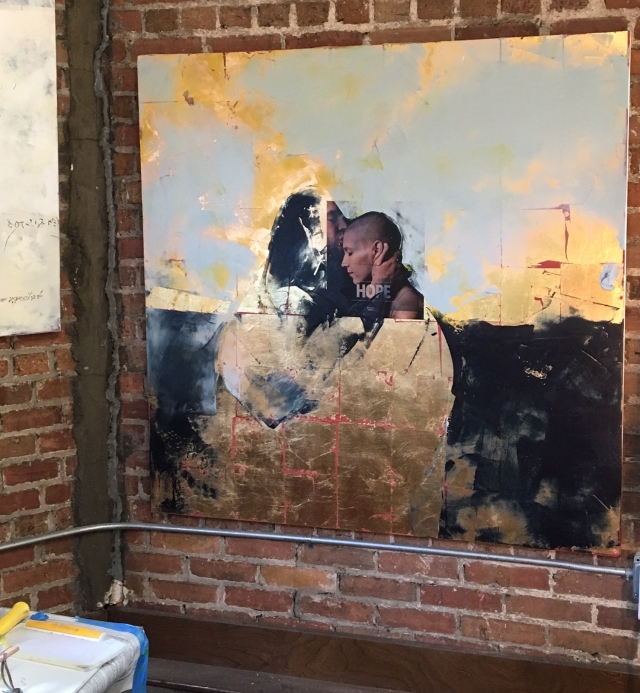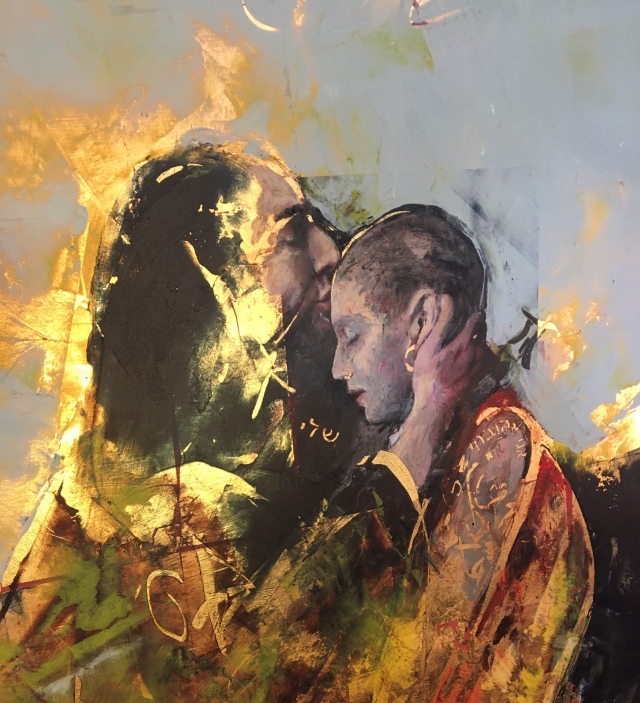For the patrons who purchased my The Return of the Prodigal — Happy New Year and Happy Anniversary too! As promised — a bit of explanation — thought process and working process for your new painting.
If you read my previous post you will know that I received a “gift of gold” the summer before last. I began to explore its use incorporating it into my paintings. In March last year, I prepared a waiting 48 x 48 inch panel with red bole as the surface on which to float the fragile leaf (water gilding). Random red lines showed between the leaf that would be incorporated into a final painting. At this point, I had no idea what this panel would evolve into. But if you look closely at the finished painting (above) you will notice that the red lines formed a red cross intersecting the two figures joined in embrace.
If you look closely, you will also notice that the leaf on the left side of the panel is a bit greener or lighter. I used the gift of antique leaf Made in Italy on the left and the leaf Made in Germany on the right. Then I turned it clockwise so the variation in shade made a bit of a horizon “where earth and sky meet in dimensions” (Micheal O’Brien).
Finally after burnishing it and using a UV sealer I could begin to paint on it.
I recalled an image that I had torn out of the weekend edition of the Wall Street Journal. It was an cancer drug ad with the large word — HOPE — written on it and a loving kiss for someone needing hope. It was a powerful image of love, so I searched for it and taped it to the gold-covered panel. It would be the inspiration for a painting about The Parable of the Prodigal Son.
Appropriation is the use of pre-existing objects or images with little or no transformation applied to them. This is a very informative link if you are not familiar with this art world terminology. The use of photography in the postmodern era has reduced the importance of drawing skills and manipulation of the image is a common and acceptable creative art form. I incorporated a found image into my painting, but integrating it successfully into a strong painting is not always easy.
The large text would have to be painted out and the figures manipulated to create two figures with bodies to beautify and strengthen the metaphor of heavenly love and the glorious embrace. Fortunately, using an image with a female cancer victim would add to the narrative that God’s grace and forgiveness are for both prodigal sons and prodigal daughters. I wanted to manipulate it to suggest either gender.

Using oils mixed with cold wax medium, I began to suggest the large shapes — the negative light shape behind the prodigal’s head and the positive dark shape of the father’s hair, which I later balanced by the dark negative shape of the foreground — dividing heaven and earth. I especially allowed the gold to come through the figure of the Father, and through his extravagant robe. I also began to paint the faces, extending the Father’s face into the gold and adding ashen tones to the Prodigal’s face.

I added green and wine paint to the Father’s robe and red paint — the color of grace — to the Prodigal’s covering. While the paint and medium were still wet, I made random marks. And later when the paint and medium had partially dried I added the Hebrew text “tattooed” on the Prodigal’s arm the text on the Father’s beard. It read, “I am my beloved’s” and my beloved’s is “mine,” from the Song of Songs (Song of Solomon 2:16). The Prodigal is no longer separated from his family. He thankfully accepts his Father’s embrace, is clothed in his Father’s robe, given his Father’s ring, and welcomed to a celebration feast.

A parable is an earthly story that has a heavenly meaning. The gold leaf background is a perfect metaphor for the lavish heavenly love of God the Father.
Jesus often spoke in parables. He told his disciples that not all would understand them, but those with eyes to see and ears to hear would understand. Read The Parable of the Prodigal Son below or in Luke 15: 11-32.
“Stories immerse us temporally in a world other than our own, and in doing so, they provide us with a deeper understanding of our own identities, values, choices, and purpose” (You Can’t Have Ethics Without Stories by Russell Moore ).
The Parable of the Prodigal Son
And he said, “There was a man who had two sons. And the younger of them said to his father, ‘Father, give me the share of property that is coming to me.’ And he divided his property between them. Not many days later, the younger son gathered all he had and took a journey into a far country, and there he squandered his property in reckless living. And when he had spent everything, a severe famine arose in that country, and he began to be in need. So he went and hired himself out to one of the citizens of that country, who sent him into his fields to feed pigs. And he was longing to be fed with the pods that the pigs ate, and no one gave him anything.
“But when he came to himself, he said, ‘How many of my father’s hired servants have more than enough bread, but I perish here with hunger! I will arise and go to my father, and I will say to him, “Father, I have sinned against heaven and before you. I am no longer worthy to be called your son. Treat me as one of your hired servants.” ’ And he arose and came to his father. But while he was still a long way off, his father saw him and felt compassion, and ran and embraced him and kissed him. And the son said to him, ‘Father, I have sinned against heaven and before you. I am no longer worthy to be called your son.’ But the father said to his servants, ‘Bring quickly the best robe, and put it on him, and put a ring on his hand, and shoes on his feet. And bring the fattened calf and kill it, and let us eat and celebrate. For this my son was dead, and is alive again; he was lost, and is found.’ And they began to celebrate.
“Now his older son was in the field, and as he came and drew near to the house, he heard music and dancing. And he called one of the servants and asked what these things meant. And he said to him, ‘Your brother has come, and your father has killed the fattened calf, because he has received him back safe and sound.’ But he was angry and refused to go in. His father came out and entreated him, but he answered his father, ‘Look, these many years I have served you, and I never disobeyed your command, yet you never gave me a young goat, that I might celebrate with my friends. But when this son of yours came, who has devoured your property with prostitutes, you killed the fattened calf for him!’ And he said to him, ‘Son, you are always with me, and all that is mine is yours. It was fitting to celebrate and be glad, for this your brother was dead, and is alive; he was lost, and is found.’ ”
The forgiving Father remains constant in his love throughout the story. He is a picture of God himself. It is the memory of the Father’s goodness that brings the prodigal son to repentance (Romans 2:4). The wayward son had no right to claim a blessing and he had nothing to offer except a life of service. But he repents. He is prepared to fall at his Father’s feet begging forgiveness and mercy. The Father sees him coming from afar and runs to embrace him. He joyfully greets him with a kiss of love. This is the moment captured in the painting.
He is so filled with jubilation at his son’s return that he doesn’t even let him confess. He does not question or lecture him but unconditionally forgives him, honors him, and accepts him back into his house. He tells the older brooding brother, “It was fitting to celebrate and be glad, for this your brother was dead, and is alive!”
God greatly loves us, patiently waits for us to repent so he can lavish us with His great mercy (Ephesians 2:1-10). What wondrous love is this!!
 An earlier Prodigal painting Weep for the Wiping of Grace was used for the cover for a 1993 issue of Christianity Today. It shows The Prodigal Son living with the pigs. He has left the splendor of his Father’s home and is huddled, seed-like, in the dark, earthy pig sty. Gold descends from his heavenly home onto three fence posts. This radical Prodigal God left the glories of his Father’s house to live with sinners. The fence posts on his back perhaps symbolize the three crosses of Golgotha — the place of Jesus’ death.
An earlier Prodigal painting Weep for the Wiping of Grace was used for the cover for a 1993 issue of Christianity Today. It shows The Prodigal Son living with the pigs. He has left the splendor of his Father’s home and is huddled, seed-like, in the dark, earthy pig sty. Gold descends from his heavenly home onto three fence posts. This radical Prodigal God left the glories of his Father’s house to live with sinners. The fence posts on his back perhaps symbolize the three crosses of Golgotha — the place of Jesus’ death.
Other paintings from 2017 using gold-leaf are The Gardener and The Miracle of the Five Loaves and Two Fish (see next post).










No words….beautiful!!! Thanks for sharing! Adrienne
Sent from my iPhone
Thank you, Adrienne 😉
If only my prodigal would come home to her heavenly Father like this. Gorgeous!
I will pray she does! Lord God please bring her home!
Pingback: Newsletter: March 24-30, 2022 – First United Methodist Church of Bristol
Is the a print or a poster of your religious works that I can purchase.
HI Julie. Yes, it is available on my website. https://gracecarolbomer.com/product/the-return-of-the-prodigal/